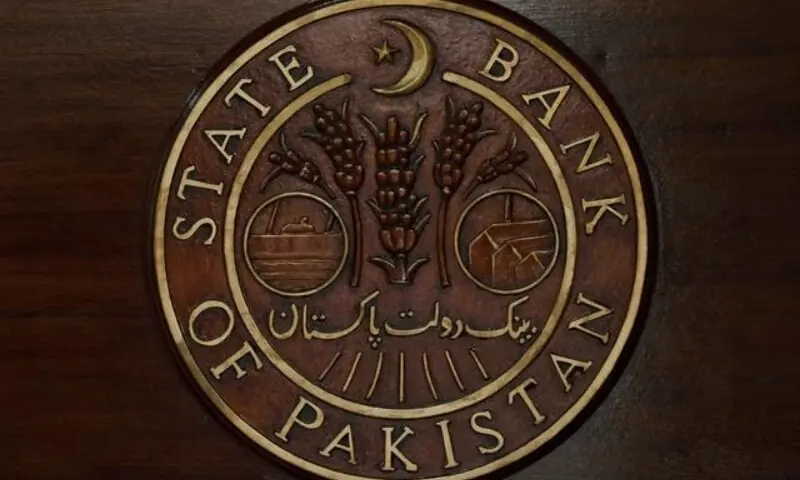
The State Bank of Pakistan (SBP) on Monday decided to keep the key interest rate unchanged at 11 per cent as policymakers weighed the impact of recent floods and higher food prices on inflation.
“The Monetary Policy Committee (MPC) decided to keep the policy rate unchanged at 11 per cent in its meeting held on October 27, 2025,” the SBP announced in a post on social media platform X.
A monetary policy statement[1], issued shortly after the announcement on X, said the MPC noted during the meeting that headline inflation “rose significantly” to 5.6pc in September, whereas core inflation remained unchanged at 7.3pc.
Regarding the rise in headline inflation, the statement said, “This largely reflected the expected flood-induced increase in food prices; an uptick in energy prices; and sticky core inflation”.
The MPC observed that, unlike previous flood episodes, the recent surge in food prices appeared to be milder than anticipated earlier, the statement said, adding that this was reflected by the “recent slowdown in price increases of major food items in high frequency SPI (sensitive price index) data, such as wheat and allied products, sugar, and perishable items”.
“Nonetheless, the Committee expects inflation to exceed the upper bound of the target range for a few months in H2-FY26, before reverting to the target range in FY27. This outlook is subject to risks from volatile global commodity prices; magnitude and timing of future energy price adjustments; and uncertainty around prices of wheat and allied products and perishable food items.”
Moreover, “the MPC assessed that the impact of the recent floods on the broader economy appears to be somewhat lower than anticipated at the time of its previous meeting[2]. The crop losses are likely to be contained, whereas supply disruptions turned out to be minimal”, the statement added.
It said that economic activity had gained further momentum, as depicted by “robust growth in high-frequency economic indicators”.
Based on these developments, the overall macroeconomic outlook had improved from the previous assessment, the statement said, adding that at the same time, the MPC noted “uncertainties around this outlook arising from volatile global commodity prices; challenging export prospects amidst the evolving tariff dynamics; and potential domestic food supply frictions”.
“In this backdrop, and given the still-unfolding impact of the earlier reduction in the policy rate, the MPC viewed today’s decision as appropriate to maintain the ongoing price stability.”
Moreover, the MPC noted some “key developments” since its last meeting. Outlining these developments, the statement firstly highlighted that real GDP growth in FY25 had been revised by the Pakistan Bureau of Statistics to 3pc from the previous estimate of 2.7pc.
“Second, initial estimates of major kharif crops by the Federal Committee on Agriculture remained close to last year’s production, despite the recent floods.
“Third, despite the repayment of a $500 million Eurobond, SBP’s foreign exchange reserves continued to increase.
“Fourth, Pakistan reached a staff-level agreement with the IMF (International Monetary Fund) on the EFF (Extended Fund Facility) and the RSF (Resilience and Sustainable Facility) reviews.
“Fifth, inflation expectations of both consumers and businesses eased in the latest SBP-IBA sentiment surveys.
“Lastly, global commodity price movements depicted mixed trends, with oil prices displaying heightened volatility.”
In light of these developments, the MPC viewed the real policy rate to be “adequately positive to stabilise inflation within the target range of 5–7pc” over the medium term, the statement said.
It added that the MPC also reiterated the “important role of the continued build-up in external and fiscal buffers to absorb future shocks and in facilitating the ongoing pickup in economic activity, without adding excessive pressures on inflation and the external account”.
Moreover, the MPC also emphasised the importance of continuing the “coordinated and prudent monetary and fiscal policies”, and undertaking the required structural reforms to ensure ongoing progress towards sustainable economic growth.
The policy rate has remained unchanged at 11 per cent since May, even as trade and industry continue to press for a substantial reduction to support economic activity.
Most analysts and researchers had expected the central bank to keep the policy rate unchanged. Bankers and market experts cited[3] two major reasons for maintaining the status quo — the recent floods in Khyber Pakhtunkhwa and Punjab that damaged crops and infrastructure, and rising inflationary pressures.
Fears of higher inflation have discouraged the central bank from considering a rate cut despite weak growth and a wide gap between inflation and the real interest rate.
SBP data shows that private-sector credit demand remains subdued, with businesses largely avoiding new borrowing even after the first quarter of the current fiscal year. Economic growth has remained sluggish over the past three years, deepening social and fiscal challenges. Nearly 97 million people are estimated to be living below the poverty line.
The government continues to struggle to revive growth and attract both domestic and foreign investment, particularly in manufacturing and agriculture. Industry leaders argue that high borrowing costs and an onerous tax regime have hurt competitiveness more than market pressures at home or abroad.
Additional input from Reuters
References
- ^ monetary policy statement (www.sbp.org.pk)
- ^ previous meeting (www.dawn.com)
- ^ cited (www.dawn.com)
